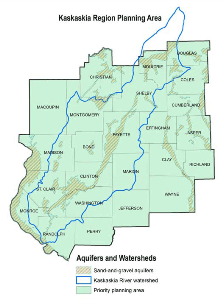Kaskaskia River

The Water Survey's initial technical report on water supply planning in the Kaskaskia River region was published in 2012 and primarily focused on surface water availability in the region, with particular interest on the two federal reservoirs, Lake Shelbyville and Lake Carlyle. Roughly 80 percent of the water supply storage in the two federal reservoirs is allocated to thermoelectric power plants in the central and lower Kaskaskia River watershed. A considerable amount of river flow in this reach is also needed to provide water for navigation and lockages at the Kaskaskia Lock and Dam.
With the water supply storage fully allocated at present, it is critical to explore how to meet future water demands for industry and power generation. There are plans to potentially build a carbon capture plant in the watershed, which would need a substantial amount of water for cooling purposes. Thus it is vital to update the yield analysis of the federal reservoirs. The other concern for water supply in the region is how to best allocate available water supply storage and how to best manage the allocation.
Most of the community reservoir supplies in the region appear to have an adequate supply. Six reservoir systems in the region are considered inadequate or at risk of water shortages, however. Most of these systems serve small communities that potentially could haul water or possibly interconnect with a larger system if faced with the threat of shortages. Several small water supply systems are looking to purchase water from neighboring systems. Monitoring conditions at water supply systems in the region is recommended to improve drought preparedness and response.
Groundwater resources are limited. Except along the river, the geology over much of the Kaskaskia River watershed is largely unfavorable for the development of community groundwater systems. For many communities the historical development of groundwater supply systems has been problematic, often resorting to using a large number of shallow wells or a long pipeline to a distant aquifer. Because shallow groundwater also does not provide a reliable source of baseflow for many of the streams in the region, most larger communities in the watershed have needed to develop reservoir storage to provide a reliable primary source of supply during drought periods.
Kaskaskia Publications
- Watershed Supply Assessment for Kaskaskia River Watershed Development: Phase I Technical Report
- Kaskaskia Basin & Vicinity 2050 Water Supply Assessment and Recommendations
- Future Water Demands and Coal Development Potential in Kaskaskia River Basin in Illinois